Related Research Articles

Sheffield Tramway was an extensive tramway network serving the English city of Sheffield and its suburbs.

A double-decker tram or double-deck tram is a tram that has two levels or decks. Some double-decker trams have open tops. Double-deck trams were once popular in some European cities, like Berlin and London, throughout the British Empire countries in the early half of the 20th century including Auckland, Christchurch and Wellington in New Zealand; Hobart, Tasmania in Australia and in parts of Asia. They are still in service or even newly introduced in Hong Kong, Alexandria, Oranjestad, Blackpool, Birkenhead, Franschhoek, Auckland and Douglas, mostly as heritage or tourist trams.
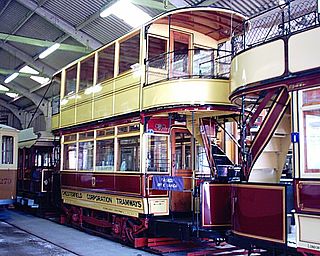
The Chesterfield and District Tramways Company and its successors ran a tramway system in the Derbyshire town of Chesterfield, England. The first horse-drawn line opened in 1882, and in 1897, the system was taken over by Chesterfield Corporation, who extended and electrified it in 1904 and 1905. Additional tramcars were purchased, but two had to be scrapped after a disastrous fire at the depot in 1916. The system suffered from a lack of maintenance as a result of reduced staffing levels during the First World War, and the trams were replaced by trolleybuses in 1927.

Warrington Corporation Tramways was the owner and operator of an electric tramway system in the early 20th century serving the town of Warrington, at the time a county borough of Lancashire, England.
The Swansea Improvements and Tramway Company operated street trams in and around Swansea in Wales from 1878 to 1937.
Edinburgh Corporation Tramways formerly served the City of Edinburgh, Scotland. The city used four-wheeled double-decked trams painted dark red (madder) and white – a livery still used by Lothian Buses and the modern light rail Edinburgh Trams.

Between 1901 and 1949 Manchester Corporation Tramways was the municipal operator of electric tram services in Manchester, England. At its peak in 1928, the organisation carried 328 million passengers on 953 trams, via 46 routes, along 292 miles (470 km) of track.
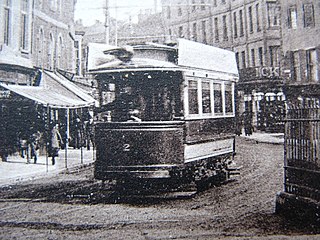
The Taunton Tramway was an electric street tramway in Taunton, the county town of Somerset, England. It operated a fleet of six narrow gauge tramcars on a single route of 1.66 miles (2.67 km) between 1901 and 1921 when the tramway closed due to a dispute over the cost of electricity.
The Southend-on-Sea trolleybus system once served the town of Southend-on-Sea, in Essex, England. Opened on 16 October 1925, it gradually replaced Southend-on-Sea Corporation Tramways.
Southend-on-Sea Corporation Tramways served the town of Southend-on-Sea in Essex from 19 July 1901 until 8 April 1942.

Torquay Tramways operated electric street trams in Torquay, Devon, England, from 1907. They were initially powered by the unusual Dolter stud-contact electrification, but in 1911 was converted to more conventional overhead-line supply. The line was extended into neighbouring Paignton in 1911 but the whole network was closed in 1934.
Accrington Corporation Tramways operated a passenger tramway service in Accrington between 1907 and 1932.
The Middlesbrough, Stockton and Thornaby Electric Tramways Company operated an electric tramway service between Middlesbrough, Thornaby-on-Tees, Stockton-on-Tees and Norton between 1898 and 1921.

Dundee and District Tramways operated a tramway service in Dundee between 1877 and 1899.
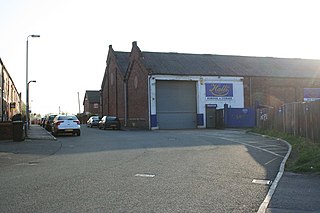
Wigan Corporation Tramways operated a tramway service in Wigan, England, between 1901 and 1931. The first tramway service in the town was run by the Wigan Tramways Company, whose horse trams began carrying passengers in 1880. They began replacing horses with steam tram locomotives from 1882, but the company failed in 1890 when a Receiver was appointed to manage it. The Wigan & District Tramways Company took over the system in 1893 and ran it until 1902. Meanwhile, Wigan Corporation were planning their own tramway system, obtaining an authorising Act of Parliament in 1893, and a second one in 1898. This enabled them to build electric tramways, and in 1902, they took over the lines of the Wigan & District Tramways Company.
At the peak of Britain’s first-generation tramways, it was possible to travel by tram all the way from Pier Head at Liverpool to the Pennines in Rochdale by tram.
Halifax Corporation Tramways operated a tramway service in Halifax, West Yorkshire, England between 1898 and 1939. After considering lifts and inclined planes to assist trams in negotiating the steep hills to the south of the town, they obtained permission to build a conventional system in 1897, and the first three routes opened in 1898. By 1905 there were 37 miles (60 km) of track and 96 tramcars, supplied by two manufacturers. In 1921, an additional route was added to the system, and the Corporation embarked on a programme of building their own tramcars, some of which replaced existing vehicles, while some extended the fleet. During the 1930s, the trams were gradually replaced by motor buses, either run by the Corporation or by private companies, and the last tram ran on 14 February 1939.
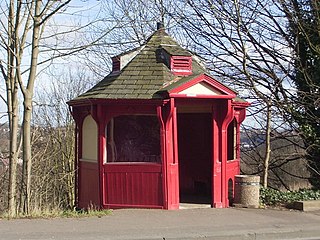
Huddersfield Corporation Tramways operated a tramway service in Huddersfield, England, between 1883 and 1940. It initially used steam locomotives pulling unpowered tramcars, but as the system was expanded, a decision was taken to change to electric traction in 1900, and the first electric trams began operating in February 1901. The system was built to the unusual gauge of 4 ft 7+3⁄4 in, in the hope that coal wagon from neighbouring coal tramways, which used that gauge, could be moved around the system. This did not occur, but two coal trams were used to delivered coal to three mills.
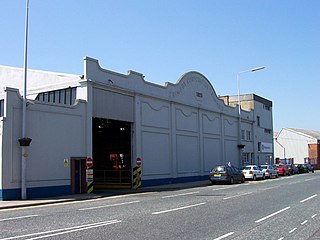
The Great Grimsby Street Tramways Company was a tramway serving Grimsby and Cleethorpes in Lincolnshire, England. It was a subsidiary of The Provincial Tramways Company. They opened a horse tramway in 1881, running from the Wheatsheaf Inn in Bargate to the border with Cleethorpes, with a branch along Freeman Street, and extended the line into Cleethorpes in 1887. It followed the trend of many British systems, and was converted to an electric tramway in December 1901. Small extensions were made to the system at both ends, but the basic plan of the system remained the same throughout its life.
Bradford Corporation Tramways were a tramway network in the city of Bradford, West Riding of Yorkshire, England which operated trams from 1882 until 1950 and trolleybuses from 1911 until 1972. The track gauge of the tramways was 4 ft.

Stockport Corporation Tramways operated a tramway service in Stockport, England, between 1901 and 1951. It was preceded by a horse tramway from Levenshulme to Stockport, which opened in 1880, and was ultimately run by the Manchester Carriage and Tramways Company. A second independent horse tramway opened in 1890, running to Hazel Grove. In 1899 the Corporation bought the first line, electrified it, and leased it back to the operating company. Their powers to buy the Stockport and Hazel Grove Tramway, authorised by the same Act of Parliament, were not exercised until 1905.
References
- ↑ The Golden Age of Tramways. Published by Taylor and Francis.
- ↑ Transport world, Volume 52, 1922
- ↑ Harley 1994, pp. 83a, 104.